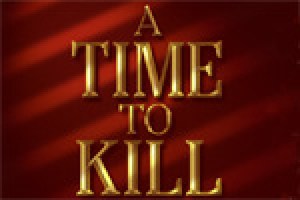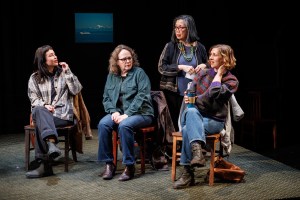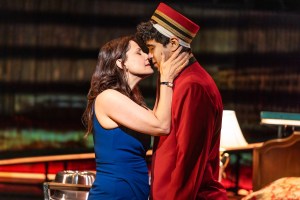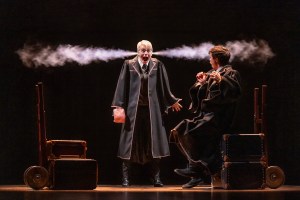A Time to Kill
Rupert Holmes takes “an eye for an eye” in his one-sided yet satisfying portrait of John Grisham’s best-selling legal thriller.
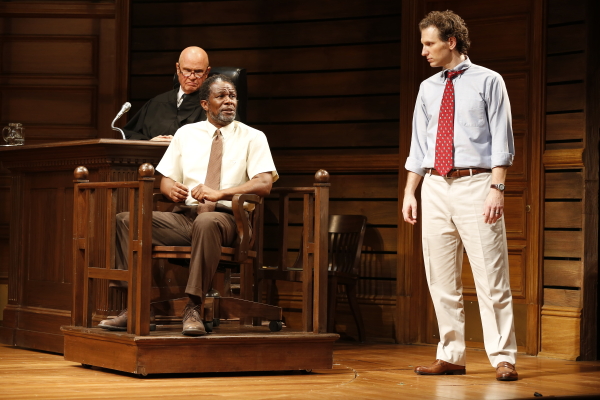
(© Carol Rosegg)
Though John Grisham’s racially charged courtroom novel A Time to Kill takes its name from Ecclesiastes 3:3 of the King James Bible, the Pete Seeger song “Turn! Turn! Turn!” more strongly comes to mind during the new stage adaptation by Rupert Holmes. Suspense builds as the rustic courtroom (designed James Noone) steadily rotates until finally slowing to a halt as the audience takes its place in the jury box. Certainly, it would be horrendously inappropriate for Holmes to conduct a popular vote among the crowd to determine the verdict of the play’s double homicide trial. Still, it wouldn’t hurt to have a tad more Drood-ian ambiguity, for any court would deem this jury pool contaminated by the production’s unabashedly preconceived notions of right and wrong.
The groundwork for the play’s moral battle is laid when two Mississippi rednecks, Billy Ray Cobb (Lee Sellars) and Pete Willard (Dashiell Eaves) are arrested for the rape and battery of a ten-year-old African-American girl named Tonya Hailey. After hearing the details of the gruesome crime, her father, Carl Lee (John Douglas Thompson), makes the calculated decision to murder both Cobb and Willard with plans of enlisting the counsel of small-town “street lawyer” Jake Brigance (Sebastian Arcelus), assuming his sympathetic case will make for an easy win. However, before pulling the trigger, he fails to consider that the racist leanings of Canton, Mississippi and the local influence of the Ku Klux Klan would make a “not guilty” verdict much more difficult to come by.
Holmes does a fine job of whittling Grisham’s nearly 700-page tome down to a concise two and a half hours (a quick two and a half hours at that, thanks to sharp direction by Ethan McSweeny), preserving this poignant racial battle at its dramatic core. However, like Grisham’s novel, as well as its popular 1996 film adaptation, the script draws too sharp a line between good and evil, making it morally reproachable for us to even consider finding fault with Carl Lee’s rogue pursuit of justice. Costume designer David C. Woolard even puts our heroic defense attorney in a light, casual suit, contrasting the dark, finely tailored attire worn by the malevolent prosecutor, a perfectly smug Patrick Page who commands the stage with his booming voice and politician smile.
Nevertheless, there is a great deal of satisfaction to be found in rooting for a stalwart underdog who takes on an irredeemably evil opponent, armed with nothing but an unpaid intern and the scales of justice. Arcelus makes for an appealing protagonist as a southern family man with boyish charm and unrelenting perseverance (who also bears an eerie resemblance to the big screen’s Jake Brigance, Matthew McConaughey). Accompanying him on team “justice” is Ashley Williams in the role of Ellen Roark, a fiery law student with encyclopedic knowledge who offers her services free of charge. Her charm adds some girlish twinkle to the male-dominated cast, though she and Arcelus lack the chemistry to make her character pop onstage — largely due to the fact that the script takes much of the meat out of their relationship. Also caught by the editing shears are the details of Jake’s domestic life with his wife and daughter, as well as the character of Lucien Wilbanks, Jake’s disbarred lush of an ex-boss, entertainingly played by television and film star Tom Skerritt (though, for a Broadway debut, he hardly scratches the surface of his talents). We are similarly gypped out of a satisfying performance by the great Tony Award-winning Tonya Pinkins, who, as Carl Lee’s wife, Gwen, only makes a few brief appearances. John Douglas Thompson, luckily, is given ample time to show off his talents. He offers an impassioned performance, capturing a helpless father’s indecipherable conglomeration of strength and weakness as he tries to right the irreversible wrongs committed against his innocent daughter.
Though the production is strictly defined as an adaptation of Grisham’s novel, nowhere mentioning the Hollywood film, McSweeny’s direction incorporates a number of cinematic flares that walk a fine line between dramatic and saccharine when translated to the stage. Video projections on the back wall (designed by Jeff Sugg) set the Southern scene while the rotating stage places the audience behind the moving lens of a camera. You can almost hear the SVU theme song as the turntable spins round and round in between scenes (especially as Law & Order alum Fred Dalton Thompson mounts his throne behind the bench as Judge Noose). Yet, just like a quick summer read or an SVU marathon, A Time to Kill will leave you with all of your fundamental cravings sufficiently indulged.

